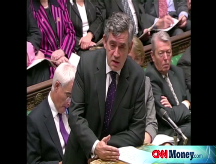What Treasury is planning
As more details emerge in the plan to rescue the U.S. financial system, questions still loom about the ins and outs of the $700 billion enterprise.
NEW YORK (CNNMoney.com) -- More light was shed on the Treasury's $700 billion rescue plan Monday, but many questions still remain.
In a conference of the Institute of International Bankers, top Treasury official Neel Kashkari outlined the government's multifaceted attempt to revive the U.S. financial system, though few new details were revealed.
Here is a glimpse at what we know about the bill, and what we've still yet to find out:
Purchasing troubled mortgage-backed securities
Under the Treasury plan, the government will buy up to $700 billion of troubled assets that financial institutions cannot unload.
These securities, most of which are pieces of bundled-together mortgages, are difficult to value, but the Treasury will establish a price for them by means of an auction. Of the $700 billion, $250 billion is available immediately, and the Treasury will need to petition Congress if it requires in excess of $350 billion.
But what remains uncertain is how the government plans to structure the pricing and purchase of the troubled assets, especially because a market value for them has been hard to establish. The Treasury said it is still in the process of designing the auction protocols, including determining what kind of assets are eligible.
Buying mortgages, particularly from regional banks
In addition to loan-backed assets, the Treasury will also be purchasing whole loans as part of its rescue initiative.
While most mortgages are combined with other home loans, divided up and sold in the form of mortgage-backed securities, some loans are not able to be securitized. The Treasury will literally buy up individual mortgages that banks cannot sell in order to shore up the bank's balance sheet.
The Treasury has not yet explained what types of loans it will purchase and how to value them. Furthermore, it is not clear what the government will do with the loans once they purchase them. They could hold onto the loan as is, or they could hire a company to service and perhaps refinance the loan.
Insuring mortgage-backed securities and mortgages
The Treasury, in an attempt to protect taxpayers, is establishing an insurance program to guarantee companies' troubled assets that were purchased before March 14, 2008. The bill, which was passed by Congress 10 days ago, stipulates that the insurance plan be funded with risk-based premiums paid by the industry.
The structure of the insurance program is still up in the air, as the Treasury has opened up a two-week period of public comment, and it will design the program after the comments are considered.
"We have several innovative ideas on how to structure this program," said Kashkari. "At the same time, we recognize that there are likely other good ideas out there that we could benefit from."
Purchasing equity in a broad array of financial institutions
Though it was not part of the initial proposal, the Treasury is using its authority from the bailout bill in order to buy up shares in banks on a voluntary basis. Though the Bush administration did not initially want the government to take equity stakes in private financial institutions, the Treasury determined that the deepening credit crisis necessitated more direct government intervention.
By buying up banks' stock, the government would directly inject much-needed capital into banks. The Treasury will only buy up shares of "healthy institutions," and will encourage participation by offering "attractive terms," according to Kashkari. The government hopes that the move will inspire banks to raise private capital as well, inspiring new confidence in the credit markets, so normal lending can resume.
But few details were offered, including criteria for a participating bank, what the bank will be offered in turn for participation and for how long the government will hold onto the equity stakes.
Helping delinquent borrowers stay in their homes
When the government buys up whole loans and mortgage-backed securities, it will try to restructure the loans so that borrowers can stay in their homes.
The Treasury hopes to prevent foreclosures by reducing loans' principals or interest rates. The goal is to help the housing market rebound sooner.
It will be easier for the government to refinance the whole loans it purchases. But most mortgages are broken up into thousands of pieces - the mortgage-backed securities - and it is still not clear how the Treasury plans to service loans that it does not entirely own the rights to. The Treasury has not yet outlined eligibility guidelines for loan restructuring or how the plan will protect taxpayers. ![]()



